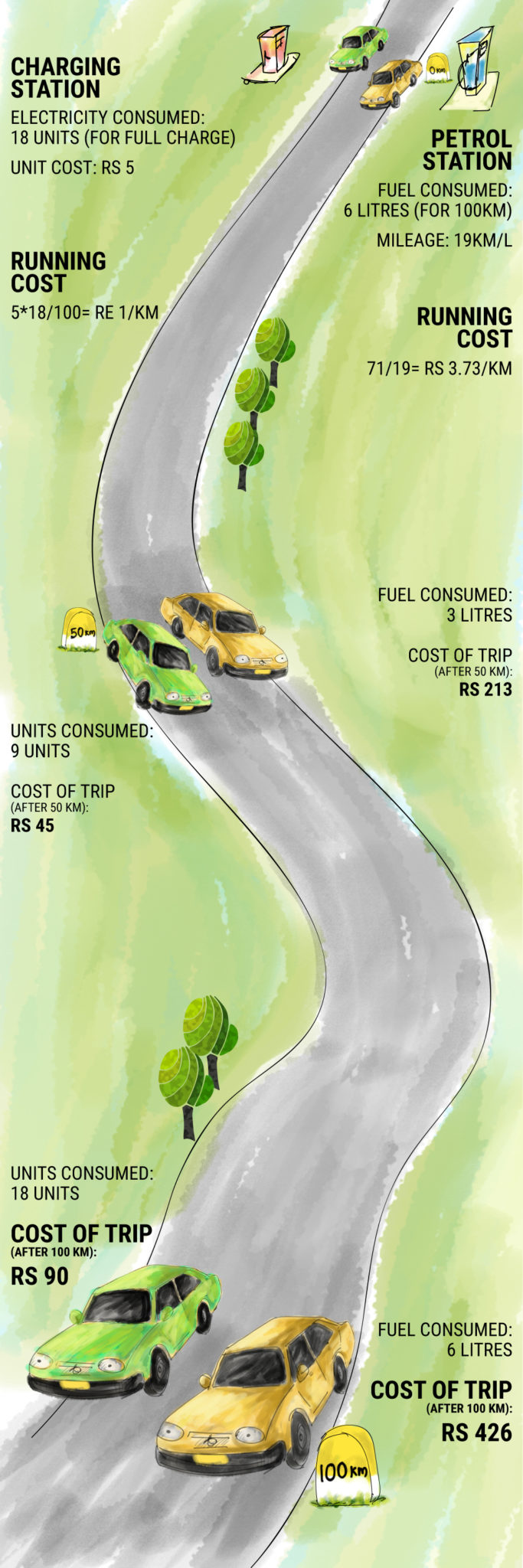If Softbank Group chairman Masayashi Son’s “wish” comes true, India will have one million electric cabs on its roads in a few years. At an event in Delhi recently, Son said he was keen on “giving away” a million electric cars to Ola drivers (SoftBank is the largest investor in Ola Cabs).
Son’s vision may well become a reality — it is completely in line with the Indian government’s ambitious goal of having only electric cars on our roads by 2030. Also, given the spiralling pollution levels in our cities, this may be the only way to go for India.
With an eye on the future, FactorDaily dived into the economics of electric vehicles (EVs) vis-a-vis that of petrol cars, and also evaluated their negatives and positives.
Petrol Vs electric: How each fared
We picked the Mahindra Verito — a revamped version of the Mahindra Logan — which has both a petrol and an electric version and seems to be a favourite with cab aggregators. Then we calculated how much it would cost to travel 100km in each version. Here’s what we found:
First up, the Mahindra Verito petrol. The company claims that the car gives a mileage of 19 kmpl on city roads (this is contestable, given the crazy traffic on Indian roads). If one was to drive 100km in the Verito petrol, at 19 kmpl, it works out to 5.26 litres. But, considering variable factors — traffic, terrain, air-conditioning — we are assuming it would take about six litres to traverse the distance.
You would spend about five times more to drive 100 km in a petrol car than an electric one — Rs 426 in the former versus Rs 90 in an EV
So, at Rs 71 per litre (current price of petrol in Bangalore), the trip would cost you Rs 426.
Let’s see how this compares against the Mahindra e-Verito, the electric version of the car. The e-Verito needs 18 units of electricity for the battery to charge fully. According to Mahindra, the car can travel 110km on one full charge. Once again, considering variable factors like traffic, terrain and stops, we are assuming that it would travel 100km on a full charge.
The average cost of electricity for domestic consumption in Bengaluru is Rs 5 per unit, which means the trip would cost you just Rs 90.
So, there you go. You would spend about five times more to drive the same distance in a petrol car than an electric one.
Cheaper, but what about downtime?
Apart from cost savings, the biggest benefit of electric cars is that you no longer need petrol or diesel — a boon in these times of depleting resources. Also, EVs are relatively low maintenance.
However, like most things in life, electric cars too have their cons. The main disadvantage being the lack of charging stations in Indian cities. There will always be a fear that you may run out of charge when you are nowhere near a station.
The main disadvantage being the lack of charging stations in Indian cities. Also, there is a recurrent downtime during charging in which you can’t drive the car
Although EVs are low-maintenance mostly, you may end up incurring big expenses on the battery. Replacing the battery can be costly — estimated to be around Rs 2.5-3 lakh.
Also, it takes about eight hours and 45 minutes to fully charge the battery. So, there is a recurrent downtime in which you can’t drive the car.
Electric cars may take over our roads
The electric vehicle industry in India is currently fledgling, with a total of 22,000 EVs sold in 2015-2016 compared to 16,000 in 2014-2015. However, with the industry and government’s thrust on EVs, the market is set to grow. About 90% of the personal vehicles on the road could be replaced by electric vehicles, says MIT expert Jessika Trancik.
With a running cost as low as Re 1, EVs could be a sustainable option for taxi aggregators in Indian cities in the future. Although the initial cost of setting up infrastructure to support electric vehicles is much higher than that of petrol/diesels vehicles, the long-term benefits are there for everyone to see.

Subscribe to FactorDaily
Our daily brief keeps thousands of readers ahead of the curve. More signals, less noise.
To get more stories like this on email, click here and subscribe to our daily brief.
Visuals: Nikhil Raj








